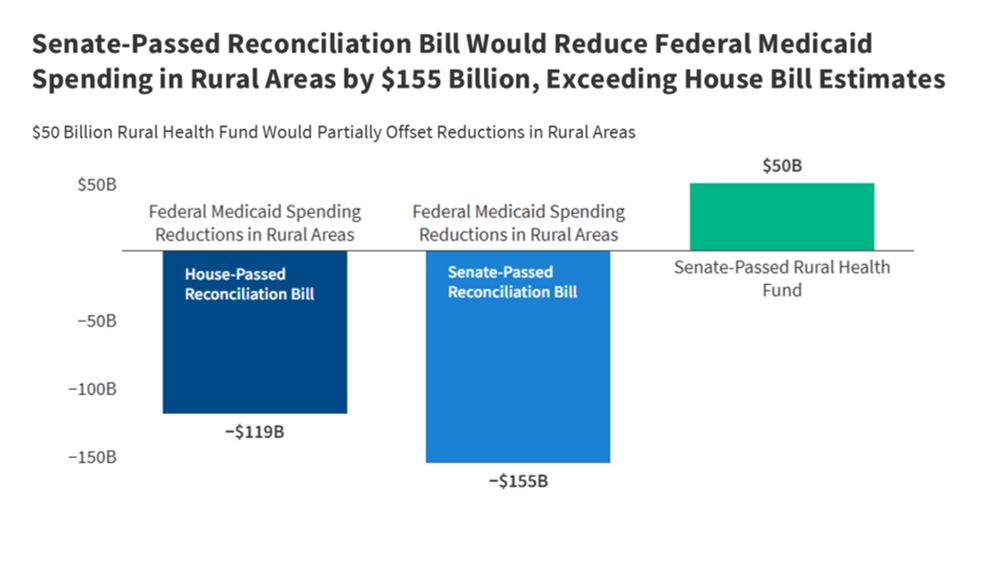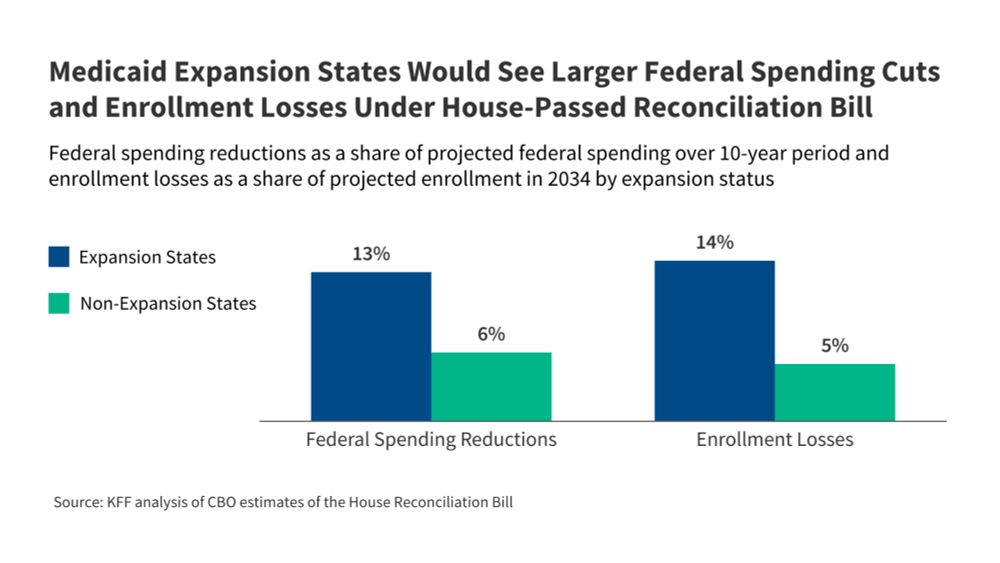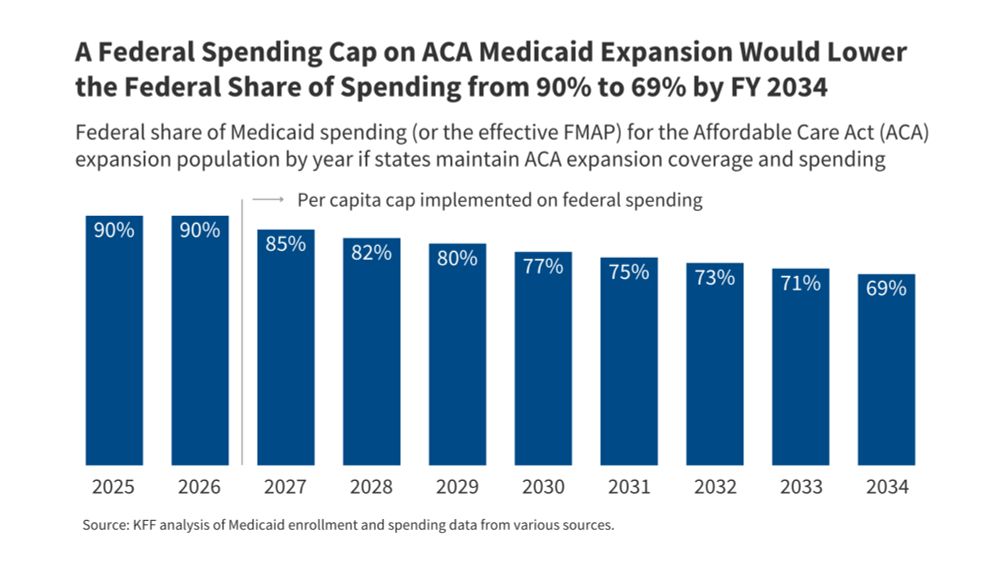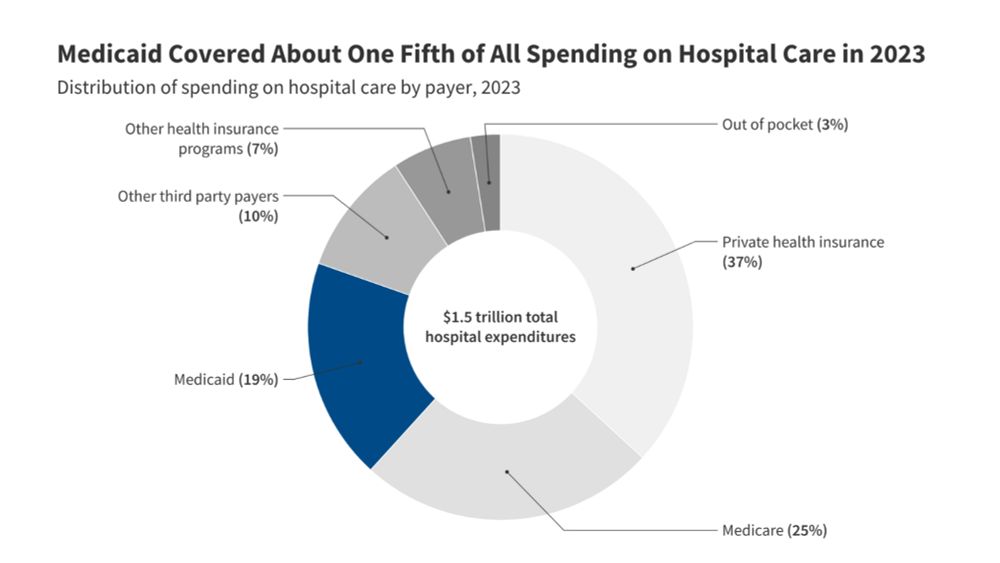
Tracking State Actions on Vaccine Policy and Access | KFF
With recent federal actions to curtail vaccine access, many states have announced actions intended to maintain broader access. This issue brief provides a snapshot of this rapidly changing landscape, ...
NEW: We analyzed recent state actions on vaccine policy, given narrowing federal guidelines. Overall, 26 states have taken some action; of these, 23 have Democratic governors, signaling a growing red/blue divide in vaccine access. @kff.org Key findings in next post ⬇️
www.kff.org/covid-19/tra...
25.09.2025 13:08 — 👍 16 🔁 12 💬 1 📌 1

KFF map titled, “47 States Allow Exemptions From School Vaccination Requirements for Religious and/or Personal Beliefs.” The map shows the type of non-medical exemption(s) from school vaccination requirements permitted by state: none (4 states), personal belief (1 state), religious (30 states), and religious and personal beliefs (16 states). The map notes that Florida has announced that they plan to eliminate school vaccine requirements but have not enacted any legislation, and West Virginia Governor Patrick Morrisey signed an executive order in January 2025 allowing religious and personal belief exemptions. Litigation is ongoing.
All states allow exemptions from school vaccination requirements for medical reasons and almost all states (47 including D.C.) allow exemptions for religious and/or personal beliefs: https://on.kff.org/4pbWQJg
15.09.2025 17:07 — 👍 9 🔁 2 💬 1 📌 0

A Look at Recent Changes to State Vaccine Requirements for School Children | KFF
This policy watch examines state-by-state school vaccine requirements and exemptions, including recent policy changes to them and the extent to which they may affect vaccination rates.
FL's recent announcement of plans to eliminate school vaccination requirements would make them the first and only state to do so.
Our NEW @kff.org piece examines school vaccine requirements (and exemptions to requirements) and recent changes across the states: www.kff.org/state-health...
12.09.2025 14:39 — 👍 8 🔁 3 💬 0 📌 0

Kindergarten Routine Vaccination Rates Continue to Decline | KFF
This issue brief provides an update on the latest trends in kindergarten children's routine vaccination and exemption rates. Over three-quarters (39) of states had measles, mumps, rubella (MMR)vaccina...
New data for the 2024-25 school year show routine vaccination rates for kindergarten children continue to decline, while exemptions from school vaccination requirements, particularly non-medical exemptions, have increased.
Check out @kff.org's UPDATED brief: www.kff.org/medicaid/iss...
06.08.2025 14:46 — 👍 1 🔁 0 💬 0 📌 0
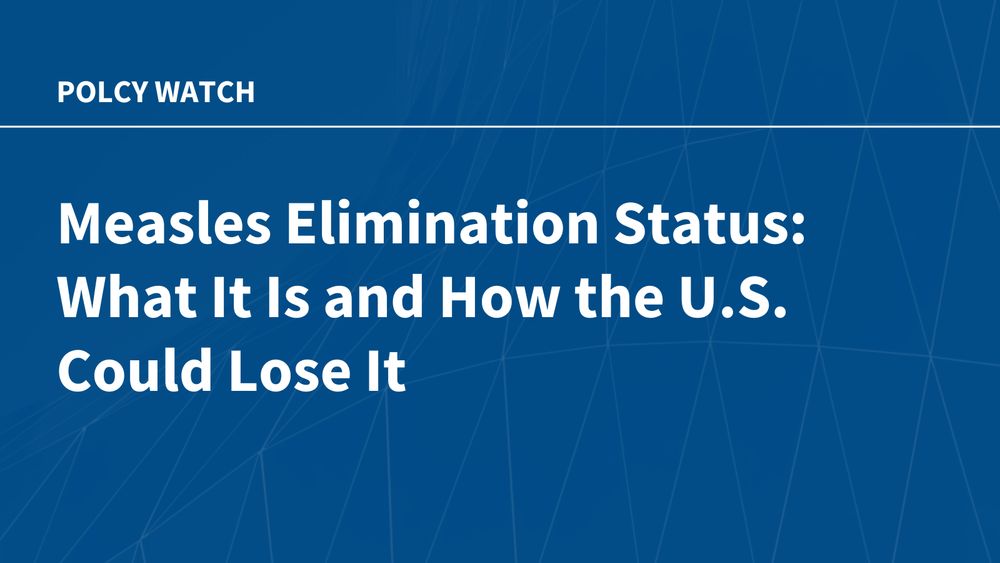
Measles Elimination Status: What It Is and How the U.S. Could Lose It | KFF
The United States is at risk of losing its measles elimination status. This post looks at what measles elimination means, how the current measles outbreak threatens this status, and what losing it…
As vaccine skepticism escalates and the number of U.S. measles cases grows, we examine what it means to eliminate measles, whether the current measles outbreak could threaten the country’s measles elimination status, and what losing that status might mean.
30.07.2025 18:36 — 👍 9 🔁 2 💬 0 📌 0
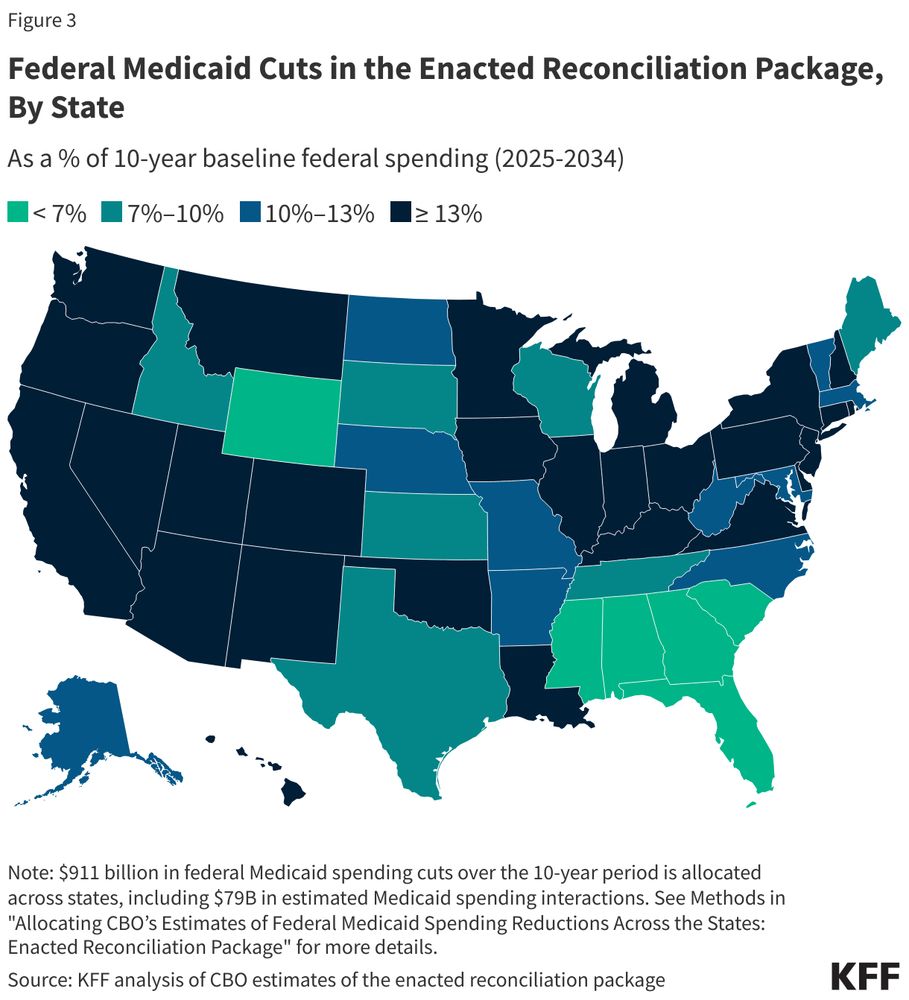
New: The Republican tax and spending mega-law will cut Medicaid in every state, but the effects are biggest in states that have expanded Medicaid under the ACA.
www.kff.org/medicaid/iss...
24.07.2025 18:24 — 👍 9 🔁 12 💬 0 📌 0

The Senate reconciliation bill would cut federal #Medicaid spending by over $200 billion more than the House bill though the increases vary by state.
In 14 states, the Senate bill would reduce federal Medicaid spending by at least $5 billion more than the House bill.
www.kff.org/quick-take/s...
02.07.2025 22:44 — 👍 12 🔁 13 💬 0 📌 0
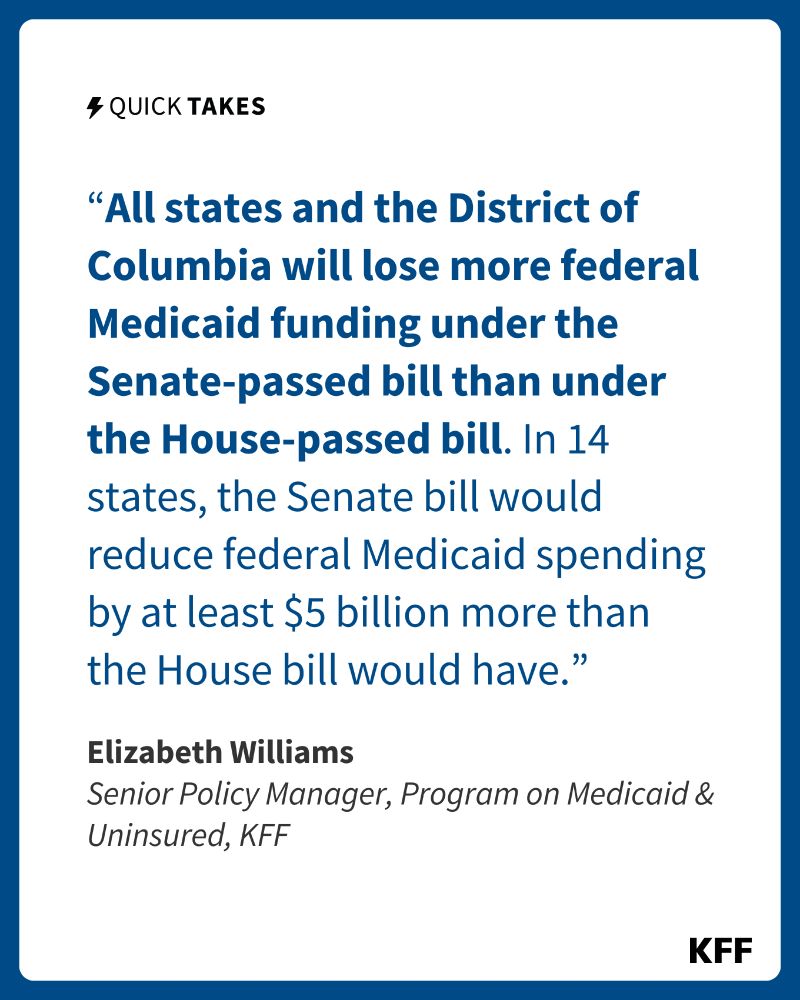
KFF graphic featuring a quote from Elizabeth Williams, KFF Senior Policy Manager, Program on Medicaid & Uninsured. It says, “All states and the District of Columbia will lose more federal Medicaid funding under the Senate-passed bill than under the House-passed bill. In 14 states, the Senate bill would reduce federal Medicaid spending by at least $5 billion more than the House bill would have.”
⚡ KFF’s @liz-williams.bsky.social compares the increases in the federal Medicaid cuts in the Senate-passed reconciliation bill with the House-passed bill across states. #QuickTake on.kff.org/44zOKRr
02.07.2025 22:15 — 👍 22 🔁 15 💬 0 📌 0

The Senate reconciliation bill would reduce federal #Medicaid spending by $1 trillion over 10 years.
Provisions that only apply to ACA expansion states account for $526 billion of the federal spending reductions.
NEW @kff.org analysis looks at the impact across states: www.kff.org/medicaid/iss...
02.07.2025 13:12 — 👍 25 🔁 20 💬 1 📌 2

Work requirements and Medicaid: What’s in the House Reconciliation bill
CBO Estimates: Implementing work requirements would account for the largest share of federal Medicaid savings — and cause the largest increase in the number of people without health insurance.
Verification requirements: States would be required to verify at application and renewal that ACA expansion enrollees meet 80 hours of work activities per month or qualify for an exemption. States could also require more frequent verification.
Implementation timeline: HHS must release guidance by end of 2025, giving states limited time to develop or change implementation plans, protocols, and systems before the Dec. 2026 implementation deadline.
State implementation choices: State choices to impose stricter requirements than the minimum federal requirements — like more frequent verification or longer look-back periods — and state capacity to automate processes will affect how many people could lose coverage.
Comparison to other waivers and proposals: The bill’s work requirement policies are more stringent than past Congressional proposals or state waivers, with no exemptions for older age and more barriers to getting and keeping coverage.
The work requirements proposed in the “One Big Beautiful Bill Act” are more stringent than previous policies considered by Congress and implemented at the state level.
As the Senate debates the bill, our analysis explains the proposals in the House-passed version.
20.06.2025 20:59 — 👍 176 🔁 113 💬 12 📌 9

Image depicts the following text:
Box 1. The impact of choosing different “look-back” periods
John lost his job and was out of work in April and May. In June, he started in a new seasonal position and worked 80 hours during the month. In July, John applies for Medicaid in an expansion state, as he qualifies for Medicaid on the basis of his income.
State A uses a 1-month look-back period when determining compliance with work requirements at application. John would be able to enroll in Medicaid (provided he meets all other program requirements).
State B uses a 3-month look-back period when determining compliance with work requirements at application. John would not qualify for Medicaid, as he was out of work in two of the three months.
A unique feature of the proposed Medicaid work requirements in the reconciliation bill is that states could choose to require individuals to work for *multiple* months prior to applying for Medicaid - meaning people with employment gaps would not qualify for Medicaid, even if currently working
23.06.2025 16:43 — 👍 14 🔁 5 💬 4 📌 0
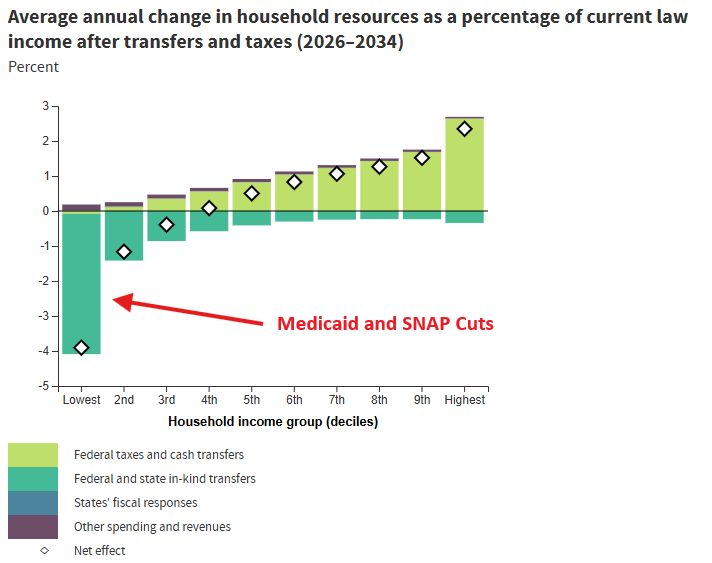
My annotation of the new distributional analysis from the Congressional Budget Office of the One Big Beautiful Bill.
www.cbo.gov/publication/...
12.06.2025 17:19 — 👍 34 🔁 18 💬 1 📌 2

KFF bar chart titled “Nearly 9 in 10 Medicaid enrollees say they are at least somewhat worried that federal funding cuts to Medicaid would negatively impact their and their families’ access to health care.” The chart shows the percent of Medicaid enrollees — including by party ID — who say that if the federal government significantly reduces its spending on Medicaid, they are very or somewhat worried it would lead to more adults and children becoming uninsured (85% Medicaid enrollees, 91% Democrats, 94% Independents, 69% Republicans); negatively impact hospitals, nursing homes, and other health care providers in your community (85% Medicaid enrollees, 93% Democrats, 96% Independents, 65% Republicans); and negatively impact their or their family’s ability to get and pay for health care (86% Medicaid enrollees, 90% Democrats, 92% Independents, 76% Republicans).
As Congress weighs spending cuts and other changes to Medicaid, our latest poll shows three-quarters of MAGA supporters and other Republicans enrolled in Medicaid are worried about the potential impact of federal spending reductions on their families.
on.kff.org/4mPUFd9
06.06.2025 16:40 — 👍 20 🔁 13 💬 2 📌 3

5 Key Facts About Medicaid and Pregnancy | KFF
This brief examines Medicaid’s pregnancy and postpartum coverage and its support for strengthening and improving maternal health outcomes.
Medicaid is the primary payer for maternity care in the U.S. It finances about 4 in 10 (41%) births nationally — nearly half in rural communities (47%).
Our new brief covers more facts you may find surprising.
29.05.2025 14:45 — 👍 44 🔁 27 💬 3 📌 0

KFF infographic showing coverage of opioid use disorder treatments among nonelderly adults. It details Medicaid's share compared to other payers in four categories: Adults with OUD (Medicaid 47%, Other 53%), Medication for OUD (Medicaid 56%, Other 44%), Outpatient OUD Treatment (Medicaid 64%, Other 36%), and Peer Support Services for SUD (Medicaid 64%, Other 36%).
Medicaid covers 47% of nonelderly adults with opioid use disorder and is the main source of coverage for those receiving treatment services.
It covers 56% of those receiving medication and 64% of those getting outpatient treatment and peer support services: on.kff.org/43kNyAB
14.05.2025 18:33 — 👍 117 🔁 47 💬 2 📌 2

Tracking the Medicaid Provisions in the 2025 Reconciliation Bill | KFF
KFF is tracking the Medicaid provisions in the 2025 federal budget bill, including new Medicaid work and verification requirements and a reduction in the expansion match rate for states that use their...
From new Medicaid work requirements to lowering expansion match rates for states that use their own funds to cover undocumented immigrants, the reconciliation bill could reshape how states fund and manage #Medicaid.
We outline the proposed provisions:
14.05.2025 14:16 — 👍 4 🔁 4 💬 0 📌 0

5 Key Facts About Children with Special Health Care Needs and Medicaid | KFF
Amid debates about proposed cuts to federal Medicaid spending, this brief analyzes key characteristics of children with special health care needs and explores how Medicaid provides them with coverage.
Options under consideration in Congress to reduce #Medicaid spending to help pay for tax cuts could have major implications for children with special health care needs.
NEW @kff.org brief explores 5 key facts about children with special health care needs and Medicaid: www.kff.org/medicaid/iss...
21.04.2025 14:13 — 👍 11 🔁 11 💬 0 📌 0
Large federal spending cuts for #Medicaid could have implications for nursing facilities bc Medicaid covers 63% of nursing home costs. Federal cuts could lead to reductions in Medicaid payment rates making it harder for nursing facilities to bolster staffing to improve the quality of patient care.
11.04.2025 16:33 — 👍 35 🔁 26 💬 2 📌 0

Medicaid and CHIP Eligibility, Enrollment, and Renewal Policies | KFF
A KFF survey of state Medicaid officials examines state Medicaid and CHIP eligibility, enrollment, and renewal policies in place as of January 2025 as states return to routine operations following the...
Check out our 23rd annual #Medicaid eligibility and enrollment survey report. Many states emerged from the unwinding with more efficient processes by maximizing the use of technology to verify income, reduce returned mail, and improve communications with enrollees. www.kff.org/medicaid/rep...
01.04.2025 22:50 — 👍 18 🔁 9 💬 0 📌 2
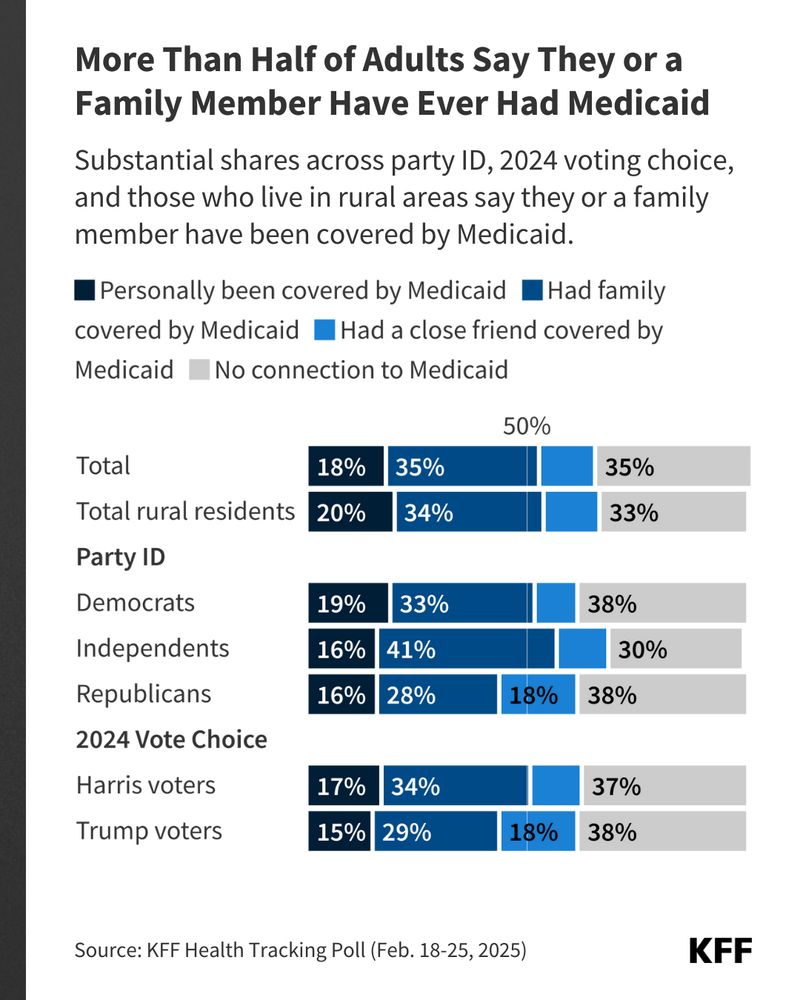
Bar chart titled "More Than Half of Adults Say They or a Familial Member Have Ever Had Medicaid Coverage." It compares the percentage of total rural residents, Democrats, Independents, Republicans, 2024 Harris voters, and 2024 Trump voters who have ever had Medicaid, a family member covered by Medicaid, or a close friend covered by Medicaid. Data sourced from KFF Health Tracking Poll (Feb. 18-25, 2023).
New KFF polling finds more than half of the public say either they themselves (18%) or a family member (35%) have ever been covered by Medicaid.
An additional 13% say they have a close friend who has ever been covered by the program: on.kff.org/43uvXb5
10.03.2025 15:19 — 👍 18 🔁 8 💬 0 📌 0

Our analysis looked at policy and state response variations in a #Medicaid per capita cap. In all cases, the 2034 % cut was bigger than the 10-year total showing that effects of the policy grow over time (and would continue beyond the budget window).
27.02.2025 00:25 — 👍 10 🔁 6 💬 0 📌 0
Senior Fellow and Director of Research, Health Policy @centeronbudget. Former Dep. Director for Economic Policy at OMB. Music lover. Views expressed are my own.
U.S. Senator from New Jersey.
Black, Asian, queer owned indie bookstore in the Petworth neighborhood of Washington, DC with a long term pop up in the Parks at Walter Reed in DC and inside Bump & Grind Analog Market in Silver Spring, MD.
Associate Director @KFF.org researching #HealthPolicy. Focus on #Medicaid, #Long-TermCare, and policies related to people with a #disability. Love to talk data and what we can learn as data access and processing improves.
U.S. Senator, Massachusetts. She/her/hers. Official Senate account.
https://substack.com/@senatorwarren
VP and Director, Racial Equity and Health Policy, @KFF.org
#Healthpolicy analysis focused on racial health disparities and immigrant health and well-being
The independent source for health policy research, polling, and news.
White House reporter at the Washington Post. Focused on politics, policy and public health. Democracy dies in darkness.
Find me on Signal: username dan_diamond.01
Writer at The Bulwark
Author of The Ten Year War
Fan of Red Sox, Dolphins, Wolverines & Billy Joel
Proud husband & dad
Email cohn [at] thebulwark.com
Signal CitizenCohn.41
I cover infectious diseases for STAT (www.statnews.com). 2020 Polk winner. Nieman '11. She/her. I write about H5N1 (in all species), Covid, polio, flu, Ebola, RSV, mpox, STIs. Find me on Signal: HBranswell.01
Award-winning public health reporter at KFF Health News. Bylines at Nature, New York Times, National Geographic & more. AmyM@kff.org Signal: AmyMaxmen.25 www.amymaxmen.com & https://kffhealthnews.org/news/author/amy-maxmen
Senior correspondent and editor at Vox. All good things in all good time. Tips/pitches: dylan.scott@vox.com.
Managing editor/local at ProPublica, past prez of AHCJ, Detroit Lions fan. Email: charles.ornstein@propublica.org. Posts are my own.
Writer and editor at The Argument
Journalist covering intersection of pharma, health policy & politics for the Pink Sheet.
On Signal at SarahKarlinSmith.34
KFF Health News’ ‘What The Health?’ panelist.
Co-created Prescription PULSE at Politico.
GWU alum, dabbled in SMPA adjunct-ness.
Reproductive health reporter @19thnews.org
I wrote UNDUE BURDEN, a book about abortion post-Dobbs. Past lives: KHN, The Texas Tribune.
Julien Baker/Boston Celtics/Jaguars enthusiast. She / Her. sbluthra(at)19thnews(dot)org; Signal: shefaliluthra.94
Covering health care at @nytimes.com. Enjoy metaphors. Dislike mixed metaphors.
Reach me on Signal: sangerkatz.01
Reporter. I make @armandalegshow — a podcast and newsletter about why health care costs so freaking much, and what we can maybe do about it.
Distributed by KUOW - Seattle's NPR station.
www.armandalegshow.com
She/her. Award-winning independent health journalist covering medical news for The New York Times, NBC News, Scientific American, AARP and others. Loves dogs and cats.









